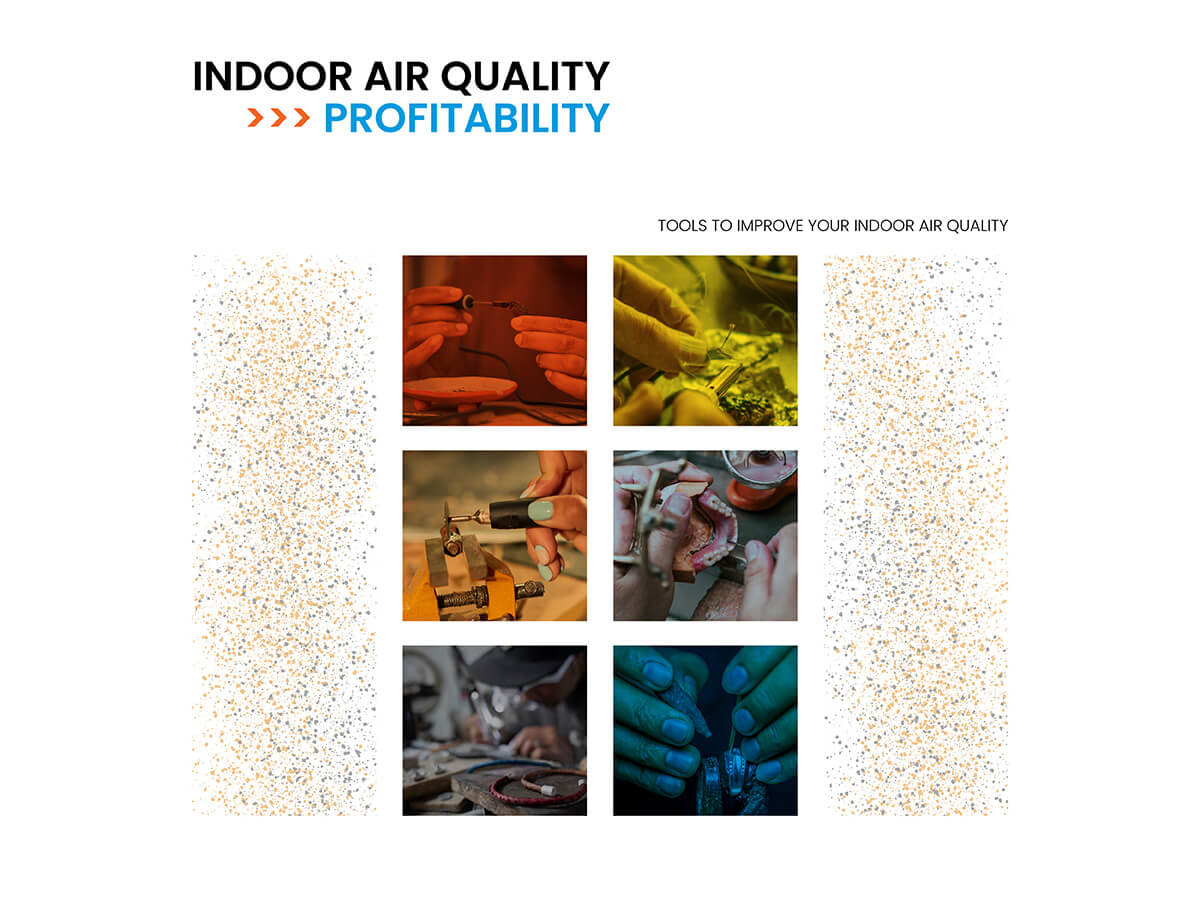
Quick jump: Dust Collection | HEPA Air Purification
Is your air polluted?
In the chaos of our daily lives, it’s easy to ignore the quality of the air we breathe. That’s understandable; there’s so much going on all around us, it’s hard to focus on what we can’t see.
But even though we can’t see air, we breathe it — constantly — and that means it’s incredibly important.
In particular, indoor work environments often lack quality measures to ensure clean indoor air. Indoor air quality (IAQ) plays a pivotal role in our health, well-being, and overall life satisfaction… not to mention the success of a business.

Part of the problem is an out-of-sight-out-of-mind approach to the air we breathe. Without obvious clouds of smoke, dust, chemicals, vapors, etc. — or without unpleasant odors — most of us don’t even think about the air quality of the places where we spend most of our time.
But we should. Industrial air pollution control isn’t just for massive plants in crowded industrial centers; workplaces of all sizes and in all locations can have air quality issues. Healthier air means a healthier workforce, and studies have shown various workplaces to have improved productivity and profitability with better IAQ.
Most sources of indoor air pollution are things we can easily overlook. According to the EPA, there are plenty of sources of indoor air pollution, including:
- Fuel-burning combustion appliances
- Tobacco products
- Building materials and furnishings as diverse as:
- Newly installed flooring, upholstery or carpet
- Modern cabinetry or furniture made of certain pressed wood products
- Deteriorated asbestos-containing insulation
- Products for household cleaning and maintenance, personal care, or hobbies
- Central heating and cooling systems and humidification devices
- Excess moisture
- Outdoor sources such as:
- Radon
- Pesticides
- Outdoor air pollution
Sources can pollute in bursts or continuously — either way, it’s important to capture pollutants as close to the source as you can, and otherwise find ways to purify, refresh, and improve the indoor air.
In a wide range of industries, the manufacture of products or execution of services can cause more pollution than many folks realize. Airborne dust particles generated during industrial processes can pose significant health risks, including respiratory issues, allergies, cognition issues, and even serious lung diseases such as silicosis.
By effectively capturing and containing these hazardous particles, clean air systems help mitigate these risks and promote a healthier work environment.
Beyond its impact on health, indoor air quality also influences our productivity and comfort levels — and, in just about every industry, that impacts profitability.
Poor IAQ can affect a workforce with symptoms like fatigue, headaches, and difficulty concentrating, which can hinder a person’s ability to work, study, or perform daily tasks effectively.
Ask yourself:
- Is it more productive/profitable when staff doesn’t call out sick?
- Is it more productive/profitable when staff morale is higher than before?
- Is it more productive/profitable when staff are able to think clearly?
If your answer is yes, then you need to start thinking of ways you can improve indoor air quality!
Tools to improve your indoor air quality
Dust collection and air purification are two easy ways to improve indoor air quality, and Vaniman has a variety of solutions. Our equipment is professional quality, adaptable, and affordable for any business.
Dust Collectors
Our lineup of industrial dust collectors covers the bases from a single dust-producing workstation to a whole lab or workshop full of dust-creating areas. Especially if you work in an industry where reclaiming valuable particulates like gold dust or 3D printing powder brings more money back in, these dust collectors will prove extremely valuable.
Dust collectors for one to two stations:
- Abrasive Vac – designed for sandblasting media, to be paired with micro abrasive sandblasters.
- Van-I-Vac – our general single-station dust collector with a high-flow motor and available filtration options.
- Voyager – for general dust collection at one or two stations, with adjustable speed and available filtration options.
For more workstations:
- StoneVac family of special application dust collectors – Vaniman’s heavy-duty workhorse lineup; all include HEPA filtration, some include our pre-filter cyclone Accumulator by default. Tell us about your particular needs; there is quite likely a StoneVac series dust collector for your application!
- V6 SE – our multi-station central dust collector, designed for up to six individual workstations simultaneously, or up to four CAD/CAM milling machines. This unit also includes HEPA filtration and available “smart” accessories to optimize the pressure and flow — and expand the life of the unit — in a busy work environment.
The pre-filter cyclone Accumulator:
Some of the dust collectors mentioned above come with an Accumulator by default, and all of them can benefit from an Accumulator, so we always recommend it. This cyclone vortex design separates 95-99% of particulates before the air even gets to the unit, trapping them in the easily-detached bucket at the bottom. This addition to a dust collector can extend its life, reduce maintenance costs — and provide quick access to the dust, if reclaiming it is the goal! (In a large jewelry shop, we’ve seen greater than 99% gold reclamation — translating to over a million dollars more per year in reclaimed gold!)
Read more: What is the Pre-Filter Cyclone Accumulator?
-
 Van-I-Vac – 10600$839.89View Details
Van-I-Vac – 10600$839.89View Details -
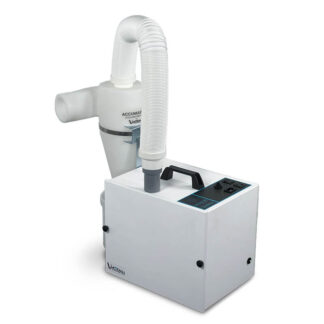 Abrasive Vac w/ Lg. Accumulator – 10660$974.46View Details
Abrasive Vac w/ Lg. Accumulator – 10660$974.46View Details -
 Voyager – 10630$991.75View Details
Voyager – 10630$991.75View Details -
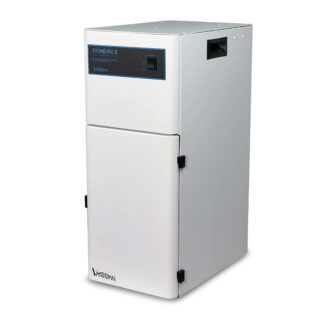 StoneVac II – 10201$1,249.87 – $1,412.28View Details
StoneVac II – 10201$1,249.87 – $1,412.28View Details -
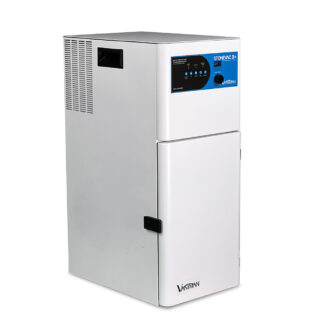 StoneVac II Plus – 10202$1,547.76 – $1,710.17View Details
StoneVac II Plus – 10202$1,547.76 – $1,710.17View Details -
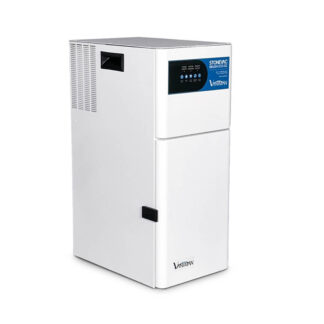 StoneVac Brushless SC – 10240$1,964.78 – $2,127.18View Details
StoneVac Brushless SC – 10240$1,964.78 – $2,127.18View Details -
 StoneVac Mill Sync for CAD/CAM – 11060$2,158.93View Details
StoneVac Mill Sync for CAD/CAM – 11060$2,158.93View Details -
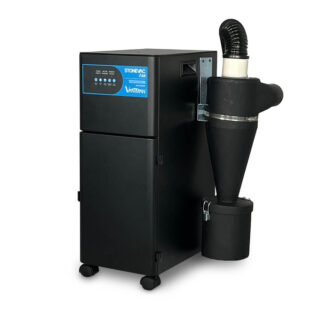 StoneVac AM – SLS 3D Printing Vacuum & Powder Recovery – 11051$2,332.34View Details
StoneVac AM – SLS 3D Printing Vacuum & Powder Recovery – 11051$2,332.34View Details
HEPA Air Purifiers
Vaniman also offers quiet and powerful HEPA air purification to supplement high-filtration ventilation. No portable air purifier is able to replace your building’s structural ventilation, but when working alongside ventilation, these products can bring indoor air quality levels up to acceptable standards. (Per the CDC, the general recommended number of air changes per hour [ACH] is five.)
- Pure Breeze HEPA Air Purifier – this commercial-grade portable HEPA air cleaner provides four levels of filtration, including dust filters, an activated carbon filter to capture odors from volatile organic chemicals, and a true HEPA filter to capture 99.97% or better of particulates as small as 0.3 µm. On its highest setting, it runs at only 56 dBA — quieter than the average human conversation! The motor is powerful enough to provide an additional 2-3 ACH for a 1,000 sq. ft. room.
- Pure Breeze HEPA Fume Hood – this mountable unit contains the same powerful motor, four-stage filtration system, and sound dampening design as its portable counterpart. It includes a capture skirt for targeted fume extraction and hardware to mount on a wall or ceiling. There is also a standing shield option for direct capture over a workstation.
- Pure Breeze FX HEPA Fume Extractor – this portable unit contains two stages of filtration (activated carbon and HEPA), capturing fumes via a wide open capture mouth at the end of a four-foot flexible hose. This unit comes with caster wheels and a foot pedal remote for hands-free start and stop. This model is excellent for small-area, targeted fume extraction.
-
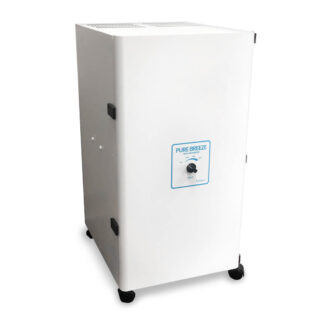 Pure Breeze HEPA Air Purifier – 10360A$1,984.66 – $2,117.53View Details
Pure Breeze HEPA Air Purifier – 10360A$1,984.66 – $2,117.53View Details -
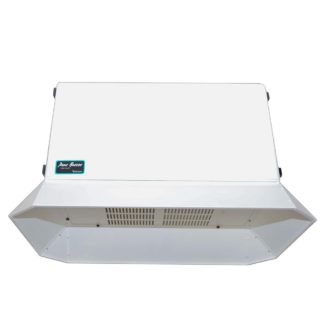 Pure Breeze HEPA Fume Hood – 10370$1,984.66View Details
Pure Breeze HEPA Fume Hood – 10370$1,984.66View Details -
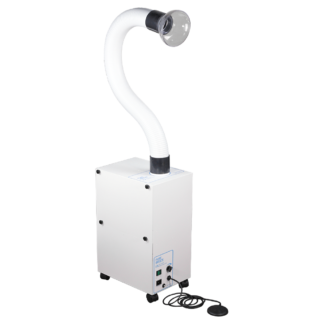 Pure Breeze FX HEPA Fume Extractor – 10380$647.87View Details
Pure Breeze FX HEPA Fume Extractor – 10380$647.87View Details -
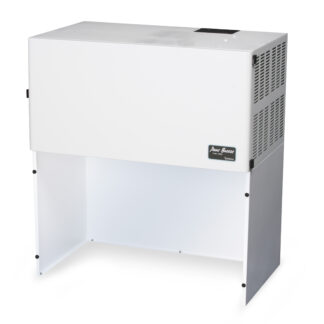 Pure Breeze Bench Top HEPA Fume Hood – 10372$2,309.49View Details
Pure Breeze Bench Top HEPA Fume Hood – 10372$2,309.49View Details
GOT QUESTIONS?
If you have any questions about our products, or about solutions for improving indoor air quality in general, please reach out to Vaniman! Our product specialists are happy to answer in detail.
SOURCES
https://www.epa.gov/indoor-air-quality-iaq/introduction-indoor-air-quality#causes
https://www.cdc.gov/coronavirus/2019-ncov/community/ventilation.html
